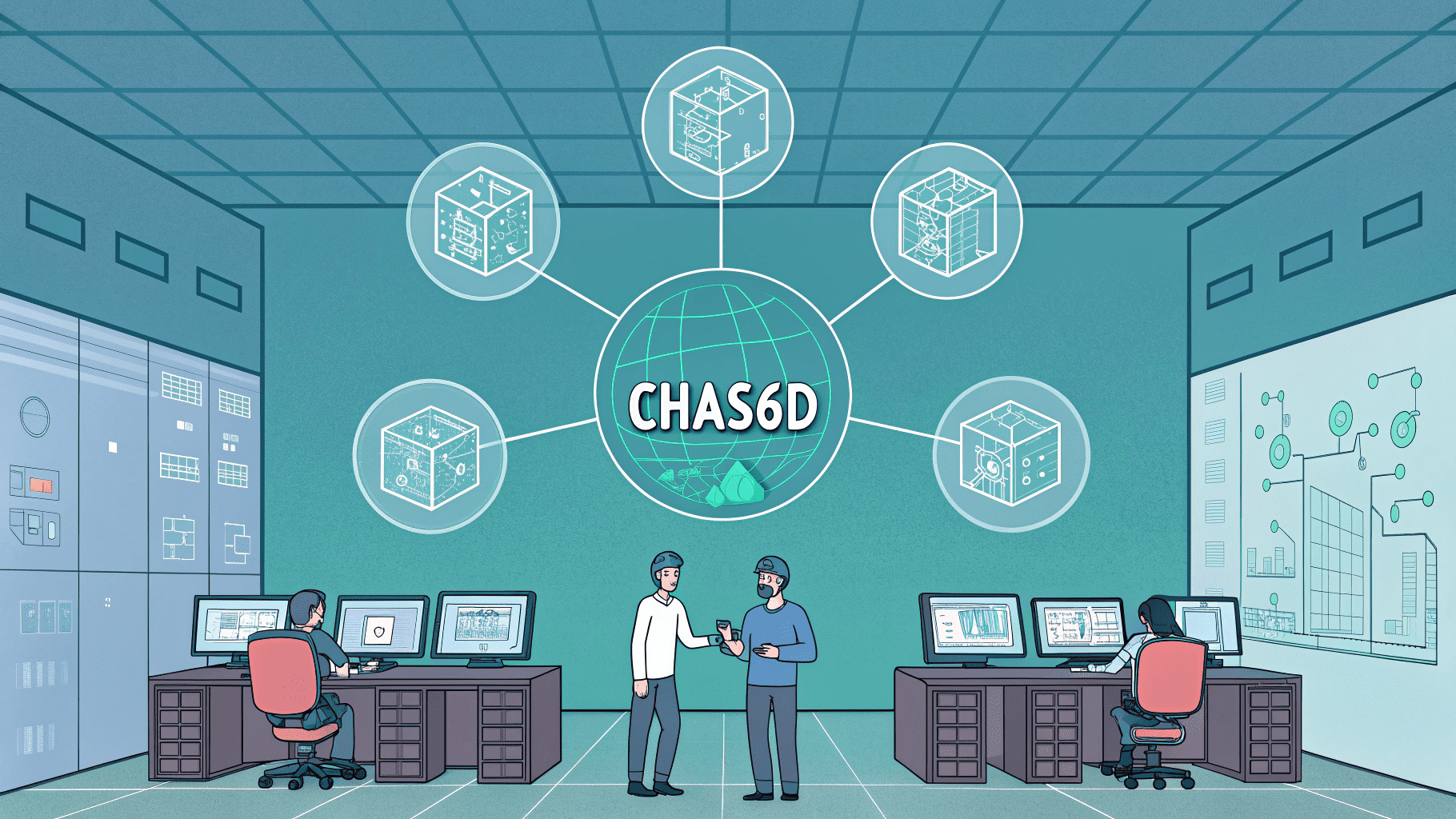
Sauflix – Streaming Platform Overview, Risks & Alternatives
July 11, 2025
Zoswerheoi – A Mysterious Term Across Tech and Ecology
July 11, 2025Chas6d is a rising digital concept that blends cybernetic thinking, adaptive systems, and layered intelligence into a unique framework. Although not widely defined, it’s often linked to six-dimensional models focusing on structure, behavior, semantics, time, and security. Some view it as a futuristic approach to system design, while others believe it may be a developer alias or an experimental protocol. Its mystery has fueled curiosity across tech forums, AI circles, and cybersecurity communities. Whether a framework or a philosophy, chas6d represents a new wave of digital innovation worth exploring.
What is Chas6d? A Complete Introduction
Chas6d is a newly emerging term that has generated curiosity across various digital spaces, from cybersecurity circles to programming communities. It appears to be associated with a conceptual or technological framework that emphasizes adaptability, system intelligence, and structural depth. While no official documentation publicly defines “chas6d” in a traditional sense, many online users refer to it as a cybernetic or multi-layered approach to digital architecture. Its name suggests a six-dimensional model that could encompass physical, behavioral, temporal, and semantic components.
The intrigue behind chas6d lies in its versatility. Some consider it a code name for a research-level software model, while others speculate that it could be a pseudonym used by a developer or digital creator. Regardless of its true form, chas6d has already made waves in niche forums, think-pieces, and digital trend analyses. Its layered structure, hinted purpose, and broad adaptability make it an exciting concept to unpack and observe in the years ahead.
The Origin and Meaning Behind the Term “Chas6d”
Though the exact origin of the term “chas6d” is unclear, there are strong hints that it stems from theoretical or experimental frameworks. The prefix “chas” may refer to cybernetic hierarchical adaptive systems, while the “6d” suffix hints at six-dimensional modeling — a concept sometimes used in advanced AI design or simulation environments. These six dimensions could relate to structure, behavior, adaptation, time, semantics, and security.
Given this theoretical foundation, the term feels engineered for conceptual flexibility. It appeals to tech-forward thinkers who embrace hybrid models and layered intelligence. The term’s undefined nature also allows different industries to interpret it in context: as a framework, a code style, a symbolic alias, or even a data philosophy. The lack of fixed meaning works in its favor, helping chas6d stand out as an intriguing digital mystery.
How Chas6d Works: Framework and Functionality Explained
Assuming chas6d functions as a digital framework, it likely operates on a layered architecture that adapts to different user or system needs. Each of the six dimensions could represent a core component of system thinking — structural elements forming the base, behavioral responses adapting to stimuli, and semantic layers understanding the meaning behind digital actions. These components collectively form a self-regulating system that evolves over time.
Its framework would emphasize feedback loops, allowing continuous learning and adjustment. Whether used in software design, intelligent automation, or secure data handling, the chas6d methodology suggests resilience and scalability. Systems built on such a model would be prepared for unpredictable environments, making it highly valuable for cybersecurity, artificial intelligence, or even digital governance. If widely adopted, it could offer a smarter way of engineering software that mimics real-world adaptability.
Top Use Cases of Chas6d in Modern Digital Systems
Chas6d’s adaptability makes it ideal for environments that demand rapid response, layered intelligence, and secure operations. In cybersecurity, a chas6d-based system could anticipate threats, reconfigure protocols, and enforce adaptive security policies in real time. This would make it particularly useful in zero-trust networks or defense-level applications.
In AI development, the framework could allow machines to not only learn from data but also understand context and adjust behavior based on semantic insights. Similarly, in business automation, a chas6d system could enhance efficiency by responding intelligently to user behavior, resource availability, and system feedback. These use cases show that whether in machine learning, IoT, or digital infrastructure, chas6d could provide the backbone for resilient and intelligent technology.
Chas6d vs Traditional Frameworks: Key Differences
What sets chas6d apart from traditional frameworks is its multi-dimensional adaptability. Conventional frameworks often rely on linear processing or pre-set rules, while chas6d appears to advocate for dynamic learning and environmental awareness. This positions it closer to modern AI paradigms than to classical software design.
Chas6d also emphasizes semantics and time as core structural elements, not just external variables. This means systems built on it could comprehend “why” something happens, not just “what” or “how.” This semantic layer allows chas6d frameworks to evolve beyond reactive logic and into a domain of meaningful action. For developers and engineers, this marks a powerful shift — one that encourages systems to think and learn as part of their core design.
Is Chas6d a Person, Platform, or Protocol?
Online speculation has led many to wonder whether chas6d is a system, a platform, or simply the username of a mysterious developer. Some GitHub traces and digital footprints suggest it might be a moniker used by someone experimenting with complex automation or encryption tools. If that’s the case, chas6d could be an alias used to test new models before their public release.
Alternatively, it may represent a small, closed-source platform or API built around the six-dimensional approach. If chas6d is a protocol, then it might serve as a new methodology for transmitting structured, meaningful, and secure data between systems. The ambiguity only adds to the mystique and keeps people guessing about its true nature.
Chas6d in Cybersecurity: Potential Risks and Benefits
If chas6d is applied in cybersecurity systems, its advantages could be revolutionary. Adaptive behavior, semantic recognition, and multi-dimensional feedback loops allow for advanced threat detection and real-time defense. Such systems could evolve based on patterns rather than relying on signature-based rules, making them harder to breach or outsmart.
However, the same adaptability could pose challenges. An overly complex system might introduce unintended vulnerabilities or make behavior harder to predict. Also, if chas6d is being used maliciously — say, as a self-modifying malware model — it could represent a serious threat to current digital defenses. Hence, understanding its exact application is crucial for both developers and security professionals.
Chas6d as a Developer Alias: Tracing the Digital Footprint
There is mounting evidence that chas6d is also being used as a digital alias across GitHub, Reddit, and lesser-known forums. In these spaces, the name is attached to scripts, code snippets, or discussions about intelligent systems, encryption, and modular automation. This points to the possibility that “chas6d” began as an identity, perhaps representing a single innovator or a small, anonymous team.
Such aliases are not uncommon in the programming world. They allow developers to test and release experimental ideas without revealing their identity. If chas6d is one such alias, it would be wise to follow the trail — not only to understand the thinker behind the model but also to see how the idea evolves across open-source platforms and tech communities.
Tools and Platforms Inspired by Chas6d Architecture
Several tools in AI, automation, and cloud orchestration echo the ideas that chas6d promotes. Frameworks like TensorFlow, Kubernetes, and LangChain may not be based directly on chas6d, but they incorporate multi-layer adaptability, semantic models, and real-time feedback loops. These similarities hint at how chas6d-like principles are influencing tech design.
Emerging startups and academic projects are also exploring similar concepts under different names. Whether it’s for intelligent workflow management or adaptive decision engines, the architecture inspired by chas6d is already taking shape in the real world. As the interest grows, more tools may publicly credit chas6d as a source of inspiration or even collaboration.
Community Reactions: What People Are Saying About Chas6d
Reactions to chas6d across forums like Reddit, X (formerly Twitter), and Discord channels range from intrigued to skeptical. Some users find the concept intellectually exciting, especially in the way it mirrors AI consciousness and semantic processing. Others express caution, calling it over-engineered or speculative.
Despite the divided opinions, one thing is clear: chas6d has captured attention. It appeals to programmers, futurists, and system designers looking for something beyond conventional frameworks. The community interest ensures that chas6d — whether a person, a method, or a mindset — will continue to spark conversation and innovation.
How to Use or Implement Chas6d in Your Tech Stack
If you’re interested in integrating chas6d-like models, begin by assessing your system’s current adaptability. Focus on multi-layered structures, dynamic inputs, and real-time decision-making. Building microservices that communicate semantically and adaptively could align with the chas6d philosophy.
You can also explore open-source tools with similar foundations, such as automation platforms that use real-time analytics or AI decision trees. While a complete chas6d software suite may not yet be publicly available, its core principles can still guide architecture design. The goal is to move from static logic to learning-driven, semantically aware systems.
Common Myths and Misconceptions About Chas6d
One popular myth is that chas6d is a complete product or application ready for deployment. In truth, there is no official public software with that name — rather, it is a concept, a framework, or an evolving alias. Another misconception is that chas6d is linked to a specific company or toolset, when in reality it is more of a decentralized idea spreading across digital spaces.
Some also assume that chas6d is related to the dark web or illegal software, due to its mysterious and technical nature. While this can’t be ruled out entirely, most signs point to legitimate research and development use. Debunking these myths is important to approach chas6d with curiosity rather than fear.
Competitors and Alternatives to Chas6d in 2025
While chas6d is unique in its approach, several frameworks offer comparable capabilities. These include Google’s DeepMind models, IBM’s Watson, and emerging semantic AI platforms like Replika AI and Anthropic Claude. Each of these emphasizes layered learning, adaptive processing, and contextual decision-making.
Chas6d also faces indirect competition from new decentralized frameworks in blockchain, especially those prioritizing secure adaptive logic. Even though no tool may fully replicate chas6d’s six-dimensional model, the rise of smart ecosystems means competition is fierce — and innovation is constant.
Final Thoughts: Should You Trust or Adopt Chas6d?
Chas6d represents a bold step into the future of digital thinking — whether as a framework, a philosophy, or an experimental identity. Its core ideas resonate with the ongoing shift from rigid programming to intelligent, adaptable, semantic systems. That alone makes it worth exploring for developers, researchers, and tech entrepreneurs.
While its current form is not fully defined, its influence is already visible in emerging trends and platforms. If you value dynamic, resilient, and context-aware systems, adopting the mindset behind chas6d may give you a competitive edge. Keep observing, stay informed, and consider how you can align your tech vision with this unfolding concept.
FAQs
1. What exactly is chas6d?
Chas6d appears to be a conceptual or experimental digital framework focused on adaptability, intelligence, and multi-layered system design.
2. Is chas6d a software tool or just a theory?
Currently, chas6d seems more like a framework or philosophy rather than a publicly available software application.
3. Who created chas6d?
The origin is unclear. Some believe it may be the alias of a developer or a team working under a pseudonym.
4. Can I implement chas6d in my own tech projects?
While no official toolkit exists, the principles of chas6d — adaptability, semantics, layered architecture — can inspire your system designs.
5. Is chas6d related to cybersecurity or AI?
Yes, its core ideas are highly relevant to both fields, particularly in secure adaptive systems and intelligent automation.
Conclusion
Chas6d is a term that may not yet have a formal definition, but its impact is already being felt across digital innovation spaces. Whether it stands for a framework, a personal alias, or an emerging philosophy in tech, chas6d challenges us to rethink how systems can behave, adapt, and evolve. Its six-dimensional concept invites deeper exploration into structures that are not only reactive but meaningfully intelligent and secure. As interest continues to grow, chas6d might evolve into a widely adopted approach or remain an underground concept shaping ideas quietly. Either way, it’s a keyword worth watching — and perhaps, experimenting with in your next digital venture.





